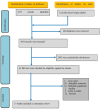Role of circulating tumor DNA and cell-free DNA biomarkers in diagnosis and prognosis of oral cancer - a systematic review
- PMID: 40217229
- PMCID: PMC11987223
- DOI: 10.1186/s12903-025-05898-3
Role of circulating tumor DNA and cell-free DNA biomarkers in diagnosis and prognosis of oral cancer - a systematic review
Abstract
Background: Oral squamous cell carcinoma is the most common malignant neoplasm of the oral cavity, contributing significantly to cancer-related mortality worldwide. Circulating tumor DNA could be a promising biomarker for the early diagnosis and prognosis of oral cancer.
Objective: The aim of this systematic review was to consolidate the existing literature on the role of circulating tumor DNA (ctDNA) and cell-free DNA (cfDNA) in the diagnosis and prognosis of oral cancer.
Methodology: The review protocol followed PRISMA guidelines. A systematic search was conducted across PubMed, Web of Science, Google Scholar and SCOPUS. Only English-language studies were included, while narrative reviews, HPV-positive OSCC, systematic reviews, meta-analyses, abstracts, and letters to the editor were excluded. Data were extracted on study design, country, sample size, participant characteristics, assessment methods, type of oral cancer and measured outcomes. Risk of bias was evaluated using Newcastle-Ottawa Scale (NOS).
Results: A total of 3,155 records were identified, out of which 17 studies met the inclusion criteria. These comprised eleven cohort studies, one was a case series, two were descriptive studies, and three were case-control studies. The studies primarily addressed oral squamous cell carcinoma (OSCC) and head and neck squamous cell carcinoma (HNSCC). Findings revealed that elevated cfDNA levels are associated with poor prognosis, lymph node metastasis, larger tumor size and advanced disease stages. ctDNA acts as a predictive tool for monitoring cancer progression, treatment response, recurrence risk, and overall survival. Among 12 studies evaluated using NOS, 8 were of good quality, while 4 were fair quality.
Conclusion: ctDNA and cfDNA exhibit promising prognostic and diagnostic potential for OSCC and HNSCC. Elevated cfDNA levels correlate with poor prognosis, while ctDNA shows potential for monitoring cancer progression and treatment response.
Keywords: CfDNA; CtDNA; Diagnosis; Head and neck cancer; Oral squamous cell carcinoma; Prognosis.
© 2025. The Author(s).
Conflict of interest statement
Declarations. Ethics approval and consent to participate: Not applicable. Consent for publication: Not applicable. Competing interests: The authors declare no competing interests.
Figures
Similar articles
-
Increased Plasma Circulating Cell-Free DNA Could Be a Potential Marker for Oral Cancer.Int J Mol Sci. 2018 Oct 24;19(11):3303. doi: 10.3390/ijms19113303. Int J Mol Sci. 2018. PMID: 30352977 Free PMC article.
-
Cell-free DNA and circulating tumor cell kinetics in a pre-clinical head and neck Cancer model undergoing radiation therapy.BMC Cancer. 2021 Oct 2;21(1):1075. doi: 10.1186/s12885-021-08791-8. BMC Cancer. 2021. PMID: 34600526 Free PMC article.
-
Can quantifying free-circulating DNA be a diagnostic and prognostic marker in oral epithelial dysplasia and oral squamous cell carcinoma?J Oral Maxillofac Surg. 2013 Feb;71(2):414-8. doi: 10.1016/j.joms.2012.04.039. Epub 2012 Jun 29. J Oral Maxillofac Surg. 2013. PMID: 22749518
-
The effect of circulating tumor DNA on the prognosis of patients with head and neck squamous cell carcinoma: a systematic review and meta-analysis.BMC Cancer. 2024 Nov 21;24(1):1434. doi: 10.1186/s12885-024-13116-6. BMC Cancer. 2024. PMID: 39574043 Free PMC article.
-
Salivary biomarkers for early detection of oral squamous cell carcinoma (OSCC) and head/neck squamous cell carcinoma (HNSCC): A systematic review and network meta-analysis.Jpn Dent Sci Rev. 2024 Dec;60:32-39. doi: 10.1016/j.jdsr.2023.10.003. Epub 2023 Dec 21. Jpn Dent Sci Rev. 2024. PMID: 38204964 Free PMC article. Review.
Cited by
-
Cell-Free DNA as a Prognostic Biomarker in Oral Carcinogenesis and Oral Squamous Cell Carcinoma: A Translational Perspective.Cancers (Basel). 2025 Jul 16;17(14):2366. doi: 10.3390/cancers17142366. Cancers (Basel). 2025. PMID: 40723249 Free PMC article. Review.
References
-
- Marsh D, Suchak K, Moutasim KA, Vallath S, Hopper C, Jerjes W, et al. Stromal features are predictive of disease mortality in oral cancer patients. J Pathol. 2011;223(4):470–81. - PubMed
-
- Rocchetti F, Tenore G, Montori A, Cassoni A, Cantisani V, Di Segni M, et al. Preoperative evaluation of tumor depth of invasion in oral squamous cell carcinoma with intraoral ultrasonography: A retrospective study. oral surgery, oral medicine. Oral Pathol Oral Radiol. 2021;131(1):130–8. - PubMed
-
- Caprioli S, Casaleggio A, Tagliafico AS, Conforti C, Borda F, Fiannacca M, et al. High-Frequency intraoral ultrasound for preoperative assessment of depth of invasion for early tongue squamous cell carcinoma: Radiological–Pathological correlations. Int J Environ Res Public Health. 2022;19(22):14900. - PMC - PubMed
Publication types
MeSH terms
Substances
LinkOut - more resources
Full Text Sources
Medical
Miscellaneous



